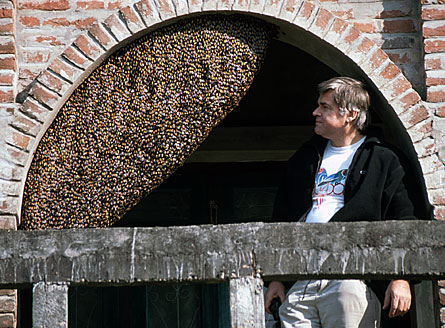Honeybees do the wave
Giant honeybees make waves when predators come close
Share this:
- Share via email (Opens in new window) Email
- Click to share on Facebook (Opens in new window) Facebook
- Click to share on X (Opens in new window) X
- Click to share on Pinterest (Opens in new window) Pinterest
- Click to share on Reddit (Opens in new window) Reddit
- Share to Google Classroom (Opens in new window) Google Classroom
- Click to print (Opens in new window) Print
By Susan Gaidos
 |
|
Bee researcher Gerald Kastberger stands next to a giant honeybee nest.
|
| Kastberger |
When a buzzing hornet comes near, most people want to run away as quickly as possible. But if the hornet targets your home, you will need to find a way to shoo it away.
Fortunately, hornets generally don’t target people’s homes. In southern Asia, however, a type of big hornet does frequently attack giant honeybees while they are clustered around their homes.
Scientists have discovered how this clever bee species drives such predators away. It uses “shimmering.”
Shimmering creates a rippling effect on the beehive. It is similar to the effect seen in a sports stadium when thousands of fans create a “wave.” The waves are created when hundreds of bees coordinate their movements and flip their abdomens upward.
Though scientists had observed shimmering in field studies, no one knew if this rippling effect would keep predators away.
Gerald Kastberger is a bee researcher at the University of Graz in Austria. He set up cameras to catch two colonies of the giant honeybees in action.
Unlike western honeybees, giant honeybees do not have outer walls on their nests. Instead, thousands of bees, in layers up to seven bees deep, surround a honeycomb.
Because the nests lack any outer protection, the bees are vulnerable to predators. These include hornets, which feed on the bees.
Kastberger recorded more than 450 shimmering events. When he reviewed his recordings, he discovered that shimmering was triggered when hornets approached the nest.
If a hornet was nearby, the bees would flip into action. This created a very fast rippling effect. If the hornets remained, or dared get closer, the shimmering increased.
Kastberger says shimmering is an example of self-organization in nature. During an attack, many bees work together to coordinate rippling waves that protect their lives and home.
Shimmering Giant Honeybees from Science News on Vimeo.
Going Deeper:







